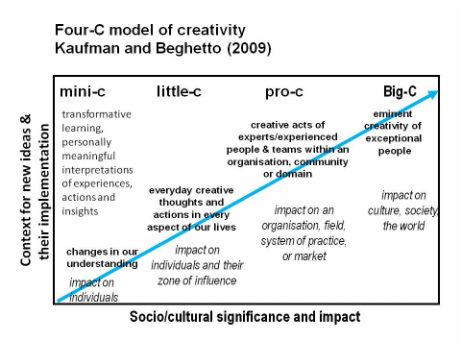
Beghetto (2007). introduced the concept of ideational code‐switching. This represents the ability to move between intrapersonal creative interpretations and interpersonal creative expression. The following paragraph summarizes the three levels of creative expression.
- Big C level contributions are pertinent and innovative ideas that can dramatically change the status quo or create a great impact on society. Individuals like Mozart and Einstein would be considered Big C category thinkers.
- Little C includes a variety of everyday creative expressions that vary depending on context. Note that creative thinking takes time and effort, so in order to encouarge creative thinking students require appropriate amount of time and limited distractions with other work. Little C contributions occur in projects, response to questions, journals, etc.
- Mini C contributions are thoughts that arise from novel and personally meaningful interpretations of experiences, actions and events. The cognitive dissonance that results may lead to novel ways of thinking and perceiving. Some examples include debates, demonstrations (science or math experiments), project-based learning, creative writing, etc.
Remember that it is important students are provided with appropriate constraints (in the form of guidelines, rubrics, criteria) for tasks while still enabling creative processes to be explored.
Although Beghetto proposed three levels of creative expression in 2007, he collaborated with Dr. Kaufman later on and published the “Fundamentals of Creativity” in 2013 where the concept of Four C Models of Creativity was introduced. The Four C Model provides a framework for including creativity in the curriculum and helping students develop their creativity to higher levels. Below I summarize the article and include my own interpretations of it.
Creativity Takes More Than Originality
Creativity involves the combination of originality and task appropriateness. Originality should occur in conjunction with academic requirements. For example, a student project may be completely original but has little learning value (does not meet curricular requirements). In this case, originality in itself does not contribute to creativity because the student does not demonstrate incorporation of new ideas into his or her repertoire.
There Are Different Levels of Creativity
This model describes the following levels of creative expression:
- mini-c, or interpretive, creativity (e.g. a student learning to combine letters for different sounds).
- little-c, or everyday, creativity (e.g. a student coming up with an original idea to write a short story about a soldier in world war II by doing research on historical events and interviewing war veterans).
- Pro-C, or expert, creativity (e.g. the idea of universal design of learning).
- Big-C, or legendary, creativity (e.g. Einstein’s theory of relativity that has an impact at a societal level).
Context Matters
Research shows that creativity can suffer when people are promised rewards for creative work, when learning conditions stress competition and social comparisons, or when individuals are highly aware of being monitored and evaluated by others. For example, a competitive environment may not foster creativity due to the high stress students are under.
Creativity Comes at a Cost
Expressing creativity involves risk-taking to have ideas heard and judged. When students understand both the potential benefits and potential costs of creativity, they will be in a position to determine whether the risk is worth it.
There’s a Time and a Place for Creativity
We may feel that creativity should be encouraged and expressed at all times. But consider this: would you want a creative surgeon or a creative bus driver? It depends. Accomplished creators know when to be creative.
Below is a graphic representation of the Four-C Model of Creativity as a function of sociocultural significance and the context in which the creative expressions would impact.

Take a moment to compare and contrast the originally proposed 3 levels of creativity and the Four C model of creativity. Which model resonates most with you and your experiences? Why?
References
Beghetto, R.A. (2007). Ideational Code-Switching: Walking the talk about supporting student creativity in the classroom. Roeper Review, 29(4) 265-270.
Beghetto, R. A., & Kaufman, J. C. (2013). Fundamentals of creativity. Alexandria: Association for Supervision and Curriculum Development.
Image source: https://www.etsy.com/au/listing/123555703/creative-juice-issue-1-digital-zine-hand
Graph source: http://www.normanjackson.co.uk/creativehe/the-four-c-model-of-creativity
Image source: https://www.google.ca/url?sa=i&source=images&cd=&ved=2ahUKEwi_-tyT68_eAhULl1QKHVU3AnoQjhx6BAgBEAM&url=http%3A%2F%2Fblog.cheetahmedialink.com%2F2013%2F04%2F26%2Fsurvey-results%2Fcreative-juice-box%2F&psig=AOvVaw3urdTysR0lPXmhRCisEmGi&ust=1542145860026382
